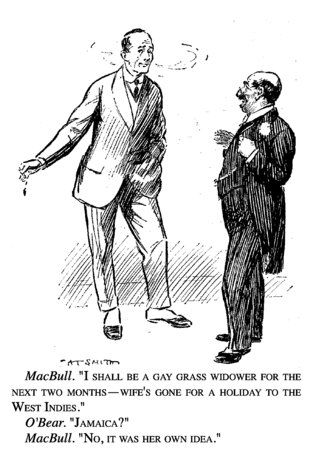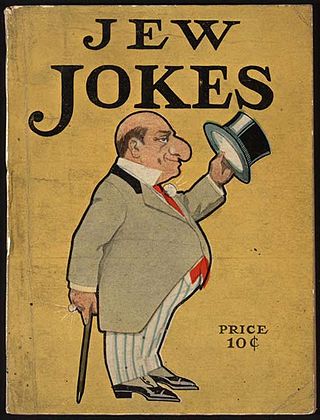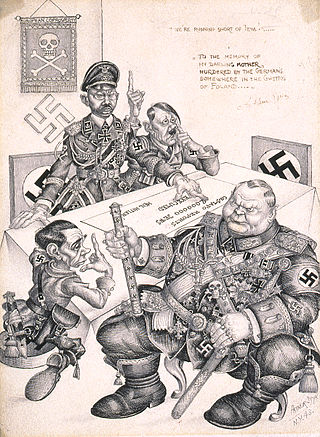
A joke is a display of humour in which words are used within a specific and well-defined narrative structure to make people laugh and is usually not meant to be interpreted literally. It usually takes the form of a story, often with dialogue, and ends in a punch line, whereby the humorous element of the story is revealed; this can be done using a pun or other type of word play, irony or sarcasm, logical incompatibility, hyperbole, or other means. Linguist Robert Hetzron offers the definition:
A joke is a short humorous piece of oral literature in which the funniness culminates in the final sentence, called the punchline… In fact, the main condition is that the tension should reach its highest level at the very end. No continuation relieving the tension should be added. As for its being "oral," it is true that jokes may appear printed, but when further transferred, there is no obligation to reproduce the text verbatim, as in the case of poetry.

A pun, also rarely known as paronomasia, is a form of word play that exploits multiple meanings of a term, or of similar-sounding words, for an intended humorous or rhetorical effect. These ambiguities can arise from the intentional use of homophonic, homographic, metonymic, or figurative language. A pun differs from a malapropism in that a malapropism is an incorrect variation on a correct expression, while a pun involves expressions with multiple interpretations. Puns may be regarded as in-jokes or idiomatic constructions, especially as their usage and meaning are usually specific to a particular language or its culture.

Toilet humour, or potty or scatological humour, is a type of off-colour humour dealing with defecation, diarrhea, constipation, urination and flatulence, and to a lesser extent vomiting and other bodily functions.

Humour or humor is the tendency of experiences to provoke laughter and provide amusement. The term derives from the humoral medicine of the ancient Greeks, which taught that the balance of fluids in the human body, known as humours, controlled human health and emotion.

Black comedy, also known as dark comedy, morbid humor, gallows humor, black humor, or dark humor, is a style of comedy that makes light of subject matter that is generally considered taboo, particularly subjects that are normally considered serious or painful to discuss. Writers and comedians often use it as a tool for exploring vulgar issues by provoking discomfort, serious thought, and amusement for their audience. Thus, in fiction, for example, the term black comedy can also refer to a genre in which dark humor is a core component. Cartoonist Charles Addams was famous for such humor, e.g. depicting a boy decorating his bedroom with stolen warning signs including "NO DIVING – POOL EMPTY", "STOP – BRIDGE OUT" and "SPRING CONDEMNED."

An ethnic joke is a remark aiming at humor relating to an ethnic, racial or cultural group, often referring to an ethnic stereotype of the group in question for its punchline.
A punch line concludes a joke; it is intended to make people laugh. It is the third and final part of the typical joke structure. It follows the introductory framing of the joke and the narrative which sets up for the punch line.
Russian humour gains much of its wit from the inflection of the Russian language, allowing for plays on words and unexpected associations. As with any other culture's humour, its vast scope ranges from lewd jokes and wordplay to political satire.

Self-referential humor, also known as self-reflexive humor, self-aware humor, or meta humor, is a type of comedic expression that—either directed toward some other subject, or openly directed toward itself—is self-referential in some way, intentionally alluding to the very person who is expressing the humor in a comedic fashion, or to some specific aspect of that same comedic expression. Here, meta is used to describe that the joke explicitly talks about other jokes, a usage similar to the words metadata, metatheatrics and metafiction. Self-referential humor expressed discreetly and surrealistically is a form of bathos. In general, self-referential humor often uses hypocrisy, oxymoron, or paradox to create a contradictory or otherwise absurd situation that is humorous to the audience.
Surreal humour is a form of humour predicated on deliberate violations of causal reasoning, thus producing events and behaviors that are obviously illogical. Portrayals of surreal humour tend to involve bizarre juxtapositions, incongruity, non-sequiturs, irrational or absurd situations, and expressions of nonsense.
German humour is the conventions of comedy and its cultural meaning within the country of Germany. German humour encompasses traditions such as Kabarett and other forms of satire as well as more recent trends such as TV shows and stand-up comedy.

Argentine humour is exemplified by a number of humorous television programmes, film productions, comic strips and other types of media. Everyday humour includes jokes related to recurrent themes, such as xenophobic jokes at the expense of Galicians (Spaniards) called chistes de gallegos, often obscene sex-related jokes, jokes about the English, the Americans, blonde women, dark humour, word and pronunciation games, jokes about Argentines themselves, etc.
Anti-humor is a type of alternative humor that is based on the surprise factor of absence of an expected joke or of a punch line in a narration that is set up as a joke. This kind of anticlimax is similar to that of the shaggy dog story. In fact, some researchers see the "shaggy dog story" as a type of anti-joke. Anti-humor is described as a form of irony or reversal of expectations that may provoke an emotion opposite to humor, such as fear, pain, embarrassment, disgust, awkwardness, or discomfort.
Computational humor is a branch of computational linguistics and artificial intelligence which uses computers in humor research. It is a relatively new area, with the first dedicated conference organized in 1996.
Although humor is a phenomenon experienced by most humans, its exact cause is a topic of heavy debate. There are many theories of humor which attempt to explain what it is, what social functions it serves, and what would be considered humorous. Although various classical theories of humor and laughter may be found, in contemporary academic literature, three theories of humor appear repeatedly: relief theory, superiority theory, and incongruity theory. These theories are used as building blocks for the rest of the theories. Among current humor researchers, there has yet to be a consensus about which of these three theories of humor is most viable. Proponents of each theory originally claimed that theirs explained all cases of humor, and that it was the only one capable of doing so. However, they now acknowledge that although each theory generally covers its area of focus, many instances of humor can be explained by more than one theory. Similarly, one view holds that theories have a combinative effect; Jeroen Vandaele claims that incongruity and superiority theories describe complementary mechanisms that together create humor.

Comedy is a genre of fiction that consists of discourses or works intended to be humorous or amusing by inducing laughter, especially in theatre, film, stand-up comedy, television, radio, books, or any other entertainment medium. The term originated in ancient Greece: In Athenian democracy, the public opinion of voters was influenced by political satire performed by comic poets in theaters. The theatrical genre of Greek comedy can be described as a dramatic performance pitting two groups, ages, genders, or societies against each other in an amusing agon or conflict. Northrop Frye depicted these two opposing sides as a "Society of Youth" and a "Society of the Old". A revised view characterizes the essential agon of comedy as a struggle between a relatively powerless youth and the societal conventions posing obstacles to his hopes. In this struggle, the youth then becomes constrained by his lack of social authority, and is left with little choice but to resort to ruses which engender dramatic irony, which provokes laughter.
Cruel jokes is a joke cycle dealing with cruelty and macabre topics. They belong to the category of sick humor. Typical examples:

There are several major aspects of humor related to the Holocaust: humor of the Jews in Nazi Germany and in Nazi concentration and extermination camps, a specific kind of "gallows humor"; German humor on the subject during the Nazi era; the appropriateness of this kind of off-color humor in modern times; modern anti-Semitic sick humor.